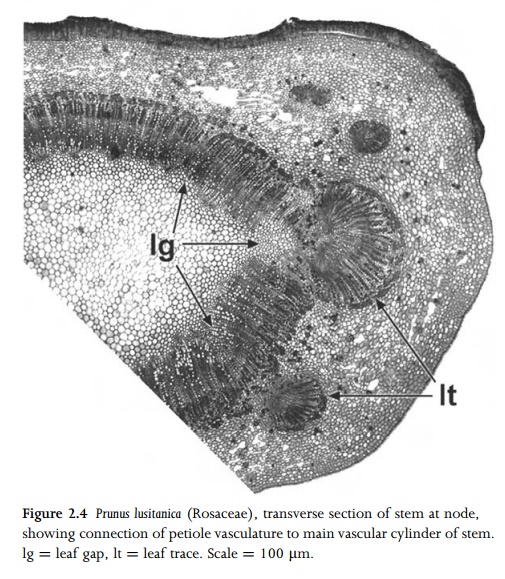Chapter: Anatomy of Flowering Plants: An Introduction to Structure and Development : Stem
Nodal Vasculature
Nodal Vasculature
At
regions of leaf insertion on the stem (nodes), the vasculature of the leaf and
stem are connected. Openings (termed lacunae or leaf gaps) occur in the stem
vascular cylinder beneath their point of contact (Fig. 2.4). In eudicots and
magnoliids, nodal anatomy is often characteristic of taxonomic groups,
particularly the number and arrangement of leaf traces and leaf gaps.

Nodes may
be unilacunar, trilacunar or multilacunar, depending on the number of leaf gaps
in the stem vascular cylinder. This feature is most obvious in stems in which there
is otherwise a continuous vascular cylinder, especially where a limited amount
of secondary thickening has taken place; as a result, nodal anatomy has been
studied far more extensively in woody than herbaceous plants54.
Sometimes the number of leaf gaps per node varies within a species or
individual, usually increasing with increased plant size and age67.
The
number of leaf traces departing from each gap is also generally characteristic
of a species, but may vary within a plant, especially in species with
unilacunar and trilacunar nodes. For example, in Clerodendrum two traces
typically depart from a single gap, and in Prunus a single trace departs from
each of three gaps in the central vascular cylinder (Fig. 2.4). In Quercus up
to five traces depart through a trilacunar node. Normally, leaf trace bundles
are initiated acropetally from the stem procambial system near the shoot apex,
to serve developing primordia. However, in some species (e.g. Populus
deltoides) subsidiary vascular bundles are initiated at the base of each
developing primordium, and grow basipetally to meet the stem procambial trace.
Nodal
vasculature is further complicated by the axillary bud vascular traces, which
are connected to the main stem vascu-lature immediately above the leaf gaps. In
most species two traces diverge to supply each bud or branch.
In large
woody trees, the junction of the trunk and its branches is characterized by a
complex arrangement of secondary vascular tissue, which typically forms a
collar around the base of the branch99. This branch collar is
enveloped by a trunk collar, which links the vascular tissue of the trunk above
and below the branch. There is no direct connection of xylem from the trunk
above a branch into the branch xylem, as the tissues are oriented perpendicular
to each other. If a branch dies, a protection zone forms around its base to
prevent spread of infection into the trunk, and the branch is often shed.
Related Topics